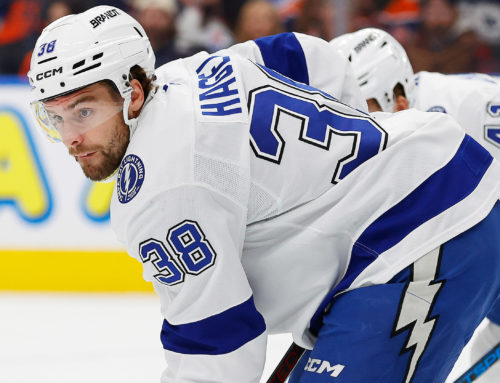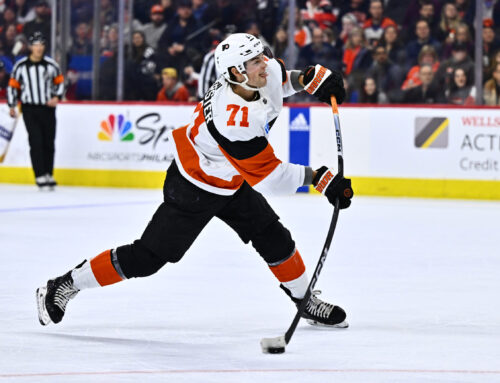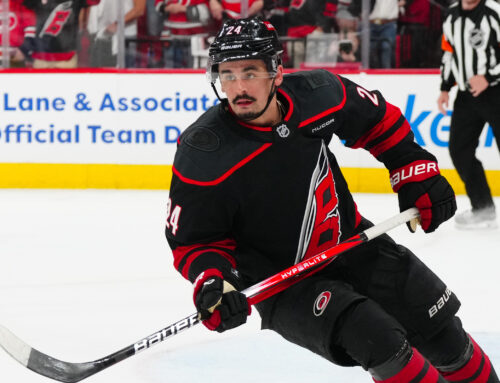Are you tired of losing your fantasy hockey pool? Sick of the teasing that comes with falling short in a close matchup? Do you long for the sweet bragging rights and financial rewards that come with a fantasy hockey title? Well, do I have something for you! Dobber's Fantasy Hockey Guide is filled with player projections, detailed analysis and fantasy insights that can make or break your fantasy season. It's invaluable in planning for fantasy drafts and evaluating trade proposals during the year. Do yourself a favour and secure a copy here!
~
In this week's Eastern Edge, we'll take a close look at two players, Jeff Skinner and Jesperi Kotkaniemi. I chose these two players because they're both coming off disappointing performances during the 2019-2020 regular season. However, some significant moves during the offseason could help both Skinner and Kotkaniemi bounce back next year.
The 2018-2019 campaign was one to remember for Jeff Skinner. He put up 40 goals, skating most of his minutes beside superstar center Jack Eichel. Skinner also played a prominent role on the team's top power-play, with eight of his goals being scored on the man advantage. Despite Skinner's individual success in 2018-2019, the Sabres finished with a disappointing 33-39-10 record – missing the playoffs for an eighth-straight season. The team suffered from a lack of depth scoring, as only the top line of Skinner, Eichel and Sam Reinhart reliably contributed to the scoresheet. Conor Sheary was the team's leading scorer outside of the top line, and he managed an underwhelming 34 points through 78 games.
Heading into the 2019-2020 campaign, it was clear that Buffalo needed more production from their second, third and fourth line. To address the issue, new head coach Ralph Krueger opted to split up the dynamic duo of Eichel and Skinner – dropping Skinner to the second line and leaving Eichel with Reinhart and rookie sensation Victor Olofsson. The move didn't exactly solve Buffalo's lack of depth scoring. While Buffalo's top line was successful again, Skinner's point totals plummeted beside lacklustre line mates. He managed just 14 goals and nine assists through 59 games, which translates to 19 goals and 12 assists over 82 games – a far cry from the 40 goals and 23 assists he tallied in 2018-2019.
Why do I mention all this? Well, it's important to consider Skinner's recent history as we project his fantasy value for next year. You see, after he scored 40 goals in his first year with Buffalo, expectations were sky-high. The team's roster hadn't changed significantly during the offseason, so it seemed likely that Skinner would play beside Eichel again. As a result, he was off the board early in most fantasy drafts, with managers expecting 35 or more goals. Unfortunately, when expectations for a player are that high, disappointment becomes the most likely outcome. With Skinner struggling last year, fantasy managers were quick to conclude that his prior success was a product of Jack Eichel. While there may be some truth to that, it's important to remember that Skinner broke the 30-goal mark three times over eight seasons in Carolina. He wasn't exactly skating alongside superstars in Carolina – but maybe you have different perceptions of Tuomo Ruutu, Chad LaRose, Derek Ryan and Lee Stempniak than I do.
With Buffalo's recent signing of Taylor Hall, even more attention has been taken away from Skinner. Hall is all but guaranteed to skate alongside Eichel at even strength, which means Skinner will likely be skating on Buffalo's second line. However, that isn't the undesirable situation that is has been in years past. With the Sabres' recent acquisition of Eric Staal, the second line center position is already stronger than it has been recently. In addition, the line will be rounded out by either Olofsson or Reinhart, creating a trio with underrated offensive upside. Now, I'm not here to sell you on the hope that Staal and Skinner have some insane chemistry from their days in Carolina – because that's not the case. They did play together for over 300 minutes during the 2013-2014 campaign – when Skinner scored 33 goals . And while they controlled 51.9-percent of the shot-share, they were outscored 14 to 18 at even strength.
Skinner's poor performance last year, combined with Hall's arrival pushing him down the depth chart, sets Skinner's fantasy value at an all-time low. However, that just means you can get him for a low cost in your fantasy leagues.
Kotkaniemi managed a 35-point pace in 2018-2019 – an impressive accomplishment for an 18-year-old rookie. Unfortunately, his sophomore campaign proved much more challenging. He finished with just eight points in 36 games during the regular season – spending some time in the AHL and some time on the sidelines while recovering from a couple of injuries. When NHL action was put on hold due to COVID-19, Kotkaniemi used the break to develop his game – particularly his skating. When the league resumed play in August, Kotkaniemi looked like a completely different player. He looked much more balanced while skating, which permitted him to be more physical. He dished out 36 hits in 10 games during the 2020 postseason. To give you some perspective, Ben Chiarot was the only Hab who had more hits than Kotkaniemi during the playoffs. And Chiarot – a physical defenseman – only managed two more hits (38) than Kotkaniemi, despite playing 10 more minutes per game! Kotkaniemi also seemed more willing to drive the net and battle for loose pucks, ultimately scoring four goals in those 10 postseason games.
I feel as though Kotkaniemi's impressive progression during the playoffs was largely overshadowed by Nick Suzuki's more obvious success. As such, I think Kotkaniemi remains underrated in fantasy formats as we enter the 2020-2021 campaign. Montreal bolstered their winger depth through the recent acquisitions of Josh Anderson and Tyler Toffoli. So, even if Kotkaniemi is playing third-line center next year, he'll be playing alongside better line mates than your typical third-line center. In addition, he'll probably see a bigger role than your typical third-line center as Montreal is expected to deploy all four lines relatively evenly. Although he may be a year or two away from the conventional breakout, I expect him to take a significant step forward next season.





 FLA
FLA CHI
CHI NYR
NYR PIT
PIT L.A
L.A COL
COL BUF
BUF UTA
UTA PHI
PHI STL
STL VAN
VAN CBJ
CBJ TOR
TOR
